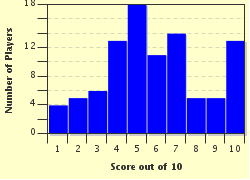Quiz Answer Key and Fun Facts
1. ALT stands for which of these?
2. Which of these tests is AST?
3. What is the test that measures the amount of bilirubin in a blood sample?
4. For which test is BUN the abbreviation?
5. HCT stands for which of these tests?
6. Which is the abbreviation for High-Density Lipoprotein?
7. MCHC stands for "multiple corpuscular hemoglobin count."
8. MCV stands for which of the following?
9. What does MPV mean?
10. TSH stands for "thyroid stimulating hormone."
Source: Author
lowtechmaster
This quiz was reviewed by FunTrivia editor
rossian before going online.
Any errors found in FunTrivia content are routinely corrected through our feedback system.

